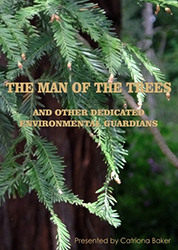- Tree Planting and Environmental Education
- info@themanofthetrees.com

My Life My Trees E-Book
August 12, 2014
Why I Am Vegetarian – By Richard St Barbe Baker
October 11, 2014INTRODUCING ‘THE MAN OF THE TREES AND OTHER DEDICATED ENVIRONMENTAL GUARDIANS’
Presented by Catriona Baker
Catriona Baker, retired Mackenzie District Runholder of Mount Cook Station, New Zealand has published her second book, ‘The Man of the Trees and Other Dedicated Environmental Guardians’ (ISBN No. 9780473264598).
Catriona’s second book is an homage to her late husband, Richard St. Barbe Baker, O.B.E., founder of The Men of The Trees, an international organisation which was first formed in Kenya in 1922 and then went on to establish branches in over one hundred countries throughout the world.
There are still a few branches of the Men of the Trees in existence including Southland, New Zealand and several in Australia, although in the United Kingdom the organisation is now known as the International Tree Foundation. This year it is celebrating its 90th anniversary with a campaign to plant one million trees throughout the world during 2014.
‘The Man of the Trees and Other Dedicated Environmental Guardians’ comprises three Parts:
Part I covers Richard St. Barbe Baker’s inspirational life as a tree-planter, environmentalist, writer and humanitarian. The book addresses his work in Kenya, the Sahara and in the United States where he successfully led a campaign to save the California Coast Redwoods. The work involved in establishing the Men of the Trees organisation in the early 1920’s is also covered together with St. Barbe’s literary achievements – thirty books, the popular TREES (Journal of the Men of the Trees organisation) and the annual Tree Lovers’ Calendar.
St. Barbe was a deeply spiritual man and Part I also features some of his favourite poetry and prayers and there is a section entitled ‘Remembering Richard St. Barbe Baker’ which includes material regarding his resting place at Woodland Cemetery, in Saskatoon, Canada, his Memorial Service in London, thanksgiving plantings of trees in New Zealand and the unveiling of a memorial in his hometown of West End, Southampton.
Part II of the book relates to a special group of twenty people from around the world, most of whom were known to St. Barbe and who shared his vision during their lives, ranging from St. Barbe’s spiritual guide and Guardian of the Baha’i Faith, Shoghi Effendi, Kikuyu Senior Chief Josiah Njonjo (St. Barbe’s interpreter and good friend in Kenya) and President Franklin Delano Roosevelt who sought St. Barbe’s advice on the establishment of the Civilian Conservation Corps during the Great Depression.
A number of New Zealanders also feature in this section of the book including Catriona Baker’s father Thomas David Burnett of Mount Cook Station, his friend Major Percy Hawkins Johnson, once owner of Raincliff Station near Fairlie and William Douglas Cook, the founder of ‘Eastwoodhill’ Arboretum in Gisborne and Pukeiti Rhododendron Trust in Taranaki.
Part III of the book features a number of inspirational ‘environmental guardians’ who continue to keep St. Barbe’s vision alive, including his own granddaughter Ann Marie Barnes in Australia, his good friend Rudy Haase, founder of the Friends of Nature Conservation Society in Canada, international arborist and tree consultant Frank Buddingh in New York, the World Wildlife Fund, and the Men of the Trees organisations that continue to do great work in Southland, New Zealand and Western Australia.
The book comprises 372 pages and an excellent collection of coloured and black and white photographs dating back to the 1920’s including some from St. Barbe’s personal collection. The book also features copies of special archival material including the Agenda for the First Meeting of the Men of the Trees organisation held in Palestine in 1929 and a selection of articles from TREES, the Journal of the Men of the Trees which was published quarterly for 45 years.
‘The Man of the Trees and Other Dedicated Environmental Guardians’ presented by Catriona Baker is a fascinating book which will hopefully inspire readers, both young and old, to become environmental guardians themselves.
“We forget that we owe our existence to the presence of trees. As far as forest cover goes, we have never been in such a vulnerable position as we are today. The only answer is to plant more trees – to plant trees for our lives.” Richard St. Barbe Baker, 1979




